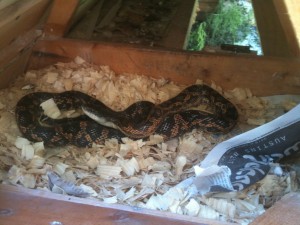Chicken Coop Tour Recap
We had 300 visitors come to visit our flock for the Funky Chicken Coop Tour yesterday! If you came by, thanks for visiting. We got lots of interest in our coop – specifically from folks who are thinking about building a similar coop and raising a small flock like ours. As mentioned previously, we used plans from Catawba ConvertiCoops and have been really happy with the coop.
I just wanted to write up a quick post with answers to the most frequently asked questions we got yesterday during the tour.
About the coop specifically, we estimate that it cost up about $200 dollars in materials and was made over the course of a couple weekends (we’re fairly handy, but not necessarily master woodworkers or anything). It’s really helpful to have a chop saw that’ll do mitered cuts for all the angled pieces. Other than that, we pretty much only used a power drill and a jigsaw to make the handles.
We got a ton of questions about predators getting at our hens. In the almost two years that we’ve had chickens in the backyard we haven’t had any problems with raccoons, possums, or anything that was after our birds. We have twice spotted a snake in the top of the coop – one time at night when the ladies were upstairs (they didn’t seem to notice the snake at all) and again during the day in the egg box (it had a big bulge in it’s belly, so it’s safe to assume that it’s interested in the eggs). A few weeks ago, Bug went outside to check for eggs, and instead of eggs, there was a piece of snake shed in the nest box – presumably we’d had a visitor earlier that day.
Both Bug and I like snakes, and the snake (or snakes) that we’ve spotted in the coop are harmless rat snakes. We already get plenty of eggs, so we’re happy to pay a small tax to the snake as long as it keeps our backyard ecosystem healthy (and takes care of varmints!).
We definitely have raccoons and opossums in our neighborhood, but they haven’t been able to get into our coop (or they haven’t tried). The plans specifically instruct you to use hardware cloth instead of mere chicken wire and poultry staples instead of just staple guns. Raccoons can rip out chicken wire fixed with staple guns. The bottom of our coop isn’t covered with anything, but you could possibly use more hardware cloth around the bottom. You could also make an apron of wire extending outward on the ground around the coop so that digging creatures would have a harder time getting in. We just haven’t had a problem yet, so we haven’t had to build a more secure fortress.
We also got a lot of inquiries about how the bird and the coop holds up in the weather. In the summer, we make sure that the coop is placed in part of the yard that gets afternoon shade (most of our yard is shaded). In the really hot summer days (when it gets over 100 degrees) we have run a fan on the coop. The birds don’t seem to mind the heat too much – their top roost is fairly well ventilated. If you’re looking at keeping hens in Texas, make sure to look for breeds that do well in heat (or all climates).
This winter we had a cold snap that dropped temperatures down into the teens for a few days in a row. During that time, we brought our whole coop into the studio (it barely fit!) and left the ladies there for a few days. That was probably more coddling then our birds needed; a week later there was another cold day but the birds were up and out scratching around downstairs first thing in the morning. It would be quite easy to run a red light bulb upstairs in the roost for really cold nights.
I’m off to rest and recoup (recoop?) but feel free to email or leave us questions in the comment section. We’re thrilled to encourage more backyard chicken keepers!
Browse Timeline
- (older) Funky Chicken Coop Tour Eve
- (newer) Good Luck to The Joiner’s Apprentice


